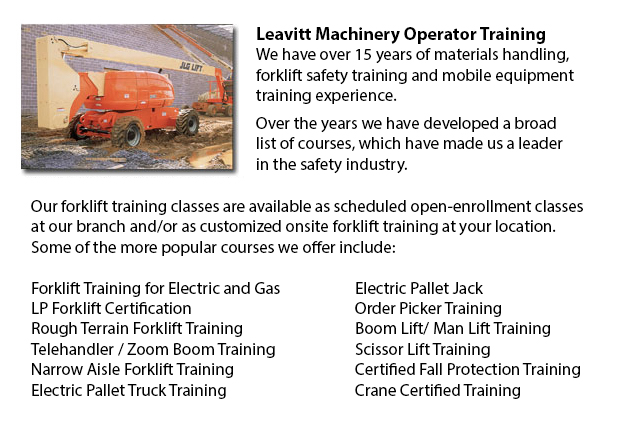
Aerial Lift Safety Training Tukwila - There are around 26 to 30 construction deaths within North America due to the use of aerial lifts. Most of the people killed are craftsmen like electrical workers, laborers, painters, carpenters or ironworkers. Most deaths are caused by falls, tip-overs and electrocutions. The greatest risk is from boom-supported lifts, such as bucket trucks and cherry pickers. The majority of the deaths are connected to this particular type of lift, with the rest involving scissor lifts. Other risks comprise being thrown out of a bucket, being struck by falling objects, and being caught between the guardrail or lift bucket and an object, such as a steel beam or joist.
The safe operation of an aerial lift needs an inspection on the following things before making use of the device: emergency and operating controls, personal fall protection gear, safety devices, and tires and wheels. Inspect for possible leaks in the air, hydraulic fluid and fuel-system. Check the device for missing or loose components.
The location where the device would be utilized must be carefully inspected for potential dangers, like bumps, holes, debris and drop-offs. Overhead power lines must be closely monitored or avoided. It is suggested that aerial lift devices be used on level, stable surfaces. Never work on steep slopes which exceed slope restrictions which the manufacturer specified. Even on a level slope, brakes, wheel chocks and outriggers should be set.
Employers are needed to provide maintenance mechanics and aerial lift operators with the right guidebooks. Mechanics and operators must be trained by a licensed individual experienced with the applicable type of aerial lift.
Aerial Lift Safety Tips:
o Close doors or lift platform chains prior to operating.
o Do not lean over or climb on guardrails. Stand on the floor of the bucket or platform.
o Make use of the provided manufacturer's load-capacity limitations.
o When working near traffic, make use of right work-zone warnings, such as cones and signs.
If right procedures are followed, electrocutions are avoidable. Stay at least 10 feet away from whatever power lines and certified electricians should de-energize and/or insulate power lines. Workers must utilize personal protective tools and equipment, like a bucket that is insulated. Nevertheless, a bucket that is insulated does not protect from electrocution if, for example, the person working touches a different wire providing a path to the ground.
Falls are preventable if the individual working remains secure in guardrails or within the bucket by making use of a positioning device or a full-body harness. If there is an anchorage in the bucket, a positioning belt along with a short lanyard is adequate.
Tip-overs are avoidable by following the manufacturer's instructions. Unless otherwise specified by the manufacturer, never drive while the lift platform is elevated. Adhere to the device's horizontal and vertical reach restrictions, and never go beyond the load-capacity which is specified.
-
Forklift Train The Trainer Tukwila
Forklift Train The Trainer Tukwila - We provide amongst the best Forklift Training programs within North America, using the latest and most advanced training techniques. Amongst our training courses are Train the Trainer courses, mobile equipment ope... More -
Crane Certification Tukwila
Crane Certification Tukwila - The Crane Certification training program covers content suggested by industry concerning the safe and efficient operation of cranes. People training will learn the following: pre-operational, operational and post operati... More -
Manlift Safety Training Tukwila
Manlift Safety Training Tukwila - It is vital for competent Manlift operators to be aware of the associated dangers which come with specific types of scissor lifts. They need to be able to operate the scissor lift in a way which protects not just the... More -
Scissor Lift Training Tukwila
Scissor Lift Training Tukwila - While operating a scissor lift, they must be utilized proficiently so as to protect the safety of the other personnel in the workplace and to protect the safety of the machine. Skilled operators are trained to drive th... More -
Crane Operator Certification Tukwila
Crane Operator Certification Tukwila - Crane Operator Certification is a process which permits people to earn a certificate to operate certain kinds of cranes. Certification includes classroom learning, hands-on practice and an ability evaluation. Se... More -
Forklift Operator Certification Tukwila
Forklift Operator Certification Tukwila - Certification for forklifts are required to guarantee the safe utilization of forklifts for those employers in construction, industrial and warehouse environments. The training has to include a method of educ... More -
Boom Lift Ticket Tukwila
Boom Lift Ticket Tukwila - Boom Lifts are a platform lift apparatus which can be raised or lowered to differing heights, making this apparatus a useful tool for various manufacturing uses. There are many distinctive types of Boom Lift consisting of k... More -
Bucket Truck Training Tukwila
Bucket Truck Training Tukwila - The bucket truck training program is a program that is designed to efficiently train qualified operators so they could lessen the chance of personal injury and incident when working in close proximity to or with bucket... More

Forklift Training Tukwila
TOLL FREE: 1-888-254-6157
Tukwila, Washington
forklifttrainingtukwila.com
Email Us
About Us


